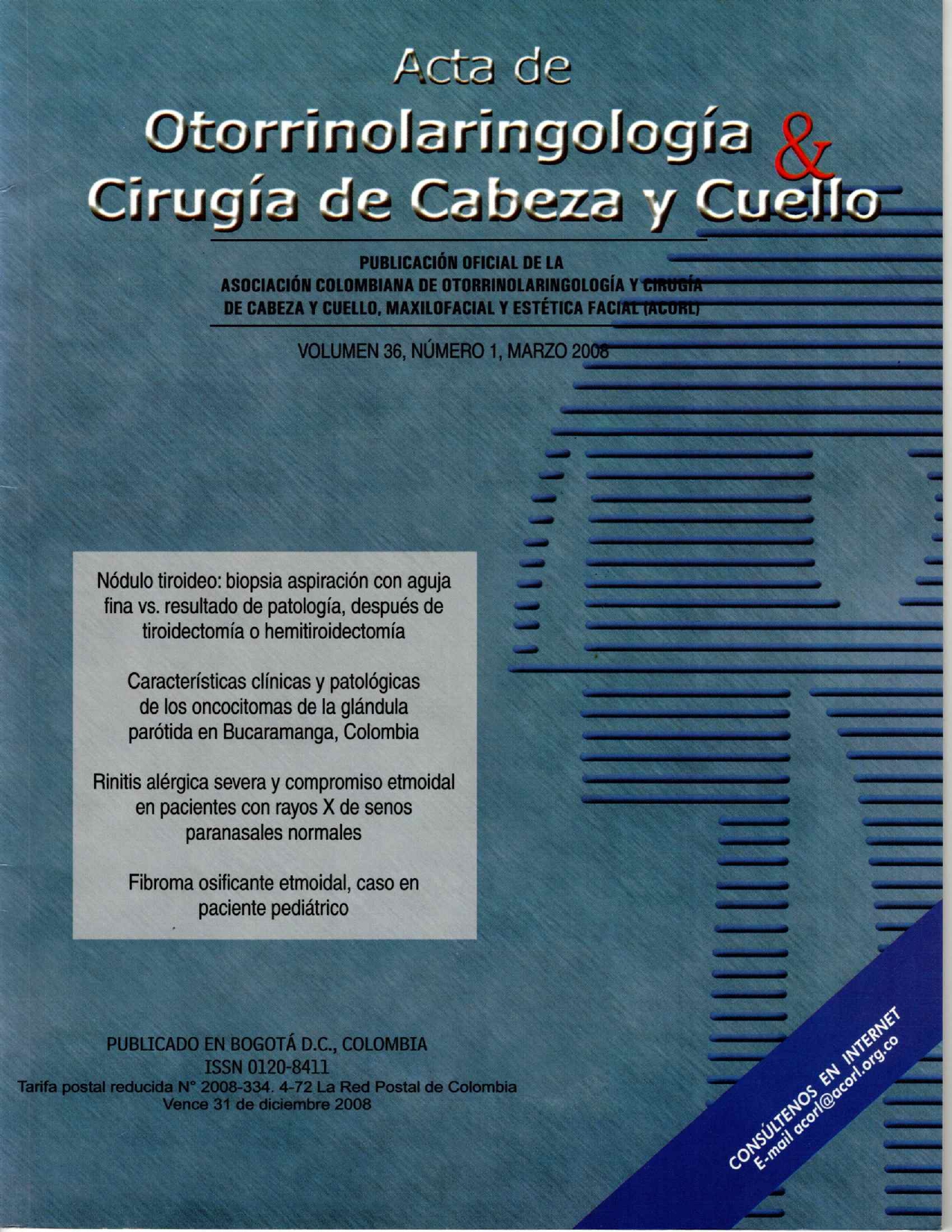Rinitis alérgica severa con compromiso etmoidal en pacientes con rayos X de senos paranasales normales
Contenido principal del artículo
Resumen
Se seleccionaron 200 pacientes con diagnóstico clínico de rinitis alérgica; con hipertrofia de cornetes inferiores que no habían mostrado mejoría clínica con manejos médicos convencionales (antihistamínicos, esteroides tópicos, infiltraciones). Tenían una placa de rayos X de senos paranasales reportada como normal y cifras de inmunoglobulina E elevadas. Se les realizó turbinoplastia o turbinectomía inferior bilateral, y durante el mismo procedimiento se practicó etmoidectomía anterior bilateral, buscando evaluar el impacto y la asociación de la patología de base con el compromiso del seno paranasal más expuesto a factores medioambientales en pacientes asintomáticos de clínica de sinusopatía. Se encontraron 143 pacientes (71,5%) con lesiones polipoideas, 35 pacientes (17,5%) con hipertrofia de mucosa y 22 pacientes (11,6%) normales.
Detalles del artículo
Sección

Esta obra está bajo una licencia internacional Creative Commons Atribución-CompartirIgual 4.0.
Este artículo es publicado por la Revista Acta de Otorrinolaringología & Cirugía de Cabeza y Cuello.
Este es un artículo de acceso abierto, distribuido bajo los términos de la LicenciaCreativeCommons Atribución-CompartirIgual 4.0 Internacional.( http://creativecommons.org/licenses/by-sa/4.0/), que permite el uso no comercial, distribución y reproducción en cualquier medio, siempre que la obra original sea debidamente citada.
eISSN: 2539-0856
ISSN: 0120-8411
Cómo citar
Referencias
Kennedy DW; Zinreich SJ; Kumar AJ et al. MR imaging of normal nasal cycle: comparison with sinus pathology. J Comput Assist Tomogr. 1988; 12: 1014-1019
Fernández Caldas; E. Fox RW environmental control of indoor air pollution. Clin Allergy. 1992; 76 (4): 935-952
Instituto de hidrología, meteorogía y estudios ambientales de Colombia. IDEAM. (Consultado 2007/VII/2). Disponible en: http:/www.ideam.gov.co.
Bradley F Marple. Allergy and contemporary rhinologist. Clin North Am 2003; 36: 941-55.
Calhoun KH, Waguespack GA, Simpson CB et al. CT evaluation of the paranasal sinuses in symptomatic populations. Otolaryngology Head Neck Surg. 1991; 104: 480-483.
Friedman RA, Harris JP. Sinusitis. Annu Rev Med 1991; 42:471-489.
Kuhn JP. Imaging of the paranasal sinuses current status. J Allergy Clin Inmunol. 1986; 77: 6-9.
Furukawa CT. The roll of allergy in sinusitis in children. J Allergy Clin Inmunol. 1992; 90: 515-517.
Fineman SM. The burden of allergic rhinitis beyond dollars and cents. Ann Allergy Asthma Inmunol. 2002; 88 (4 suppl 1) 2-7.
Hayas TE, Motbey JA, Gullane PJ. Prevalence of incidence as formalities on computed tomography scans or the paranasal sinuses. Archotolaringology Head Neck Surg. 1988; 114: 856- 859.
Newacheck PW Staddard JJ. Prevalence and impact of multiple childhood chronic illnesses. J Pediatric. 1994; 124: 40-48
Yousem DM, Kennedy DW. Rosenberg S. Ostiomeatal complex
risk factors for sinusitis: CT evaluation. J otolaryngol. 1991; 20; 419-424.
Lund VJ, Kennedy DW, Draf W y cols, Quantification for of staying sinusitis. Ann Otol Rhinol Laryng Suppl. 1995; 167: 17-21.
Moser FG, Panusih D, Rubin JS and cols. Incidental paranasal sinus abnormalities on MRI of the brain. Clin Radiol. 1991; 43: 252-254.
Rak KM, Newell JD 2d, Yakes WF et al. Paranasal sinuses on MRI images of the brain, significance of mucosal thickening. Am J Roetgenol. 1991; 156: 381-4.
Scuderi AJ, Hansberger HR, Boyer RS. Neumatization of the paranasal sinuses normal – features of importance to the accurate interpretation of ct scans and MR images – Am J and Roentgenol. 1993; 160: 1001-1104.
Shapiro GG, Bierman CW Furukawa CT, et al. Allergy Skin testing science or quackery. 1977; 59: 495-498.
Babbel RW, Hansberger HR, Sonkens Hunt. Recurring patterns or inflammatory sinuses disease demonstrated on screening sinus CT. AJNR Am Neuroradio. 1992; 13: 903-912.
Bolger WE, Butzin CA, Parsons DS. Paranasal sinus bony anatomic, variations and mucosal al normality‘s: CT analysis for endoscope, sinus surgery. Laryngoscope. 1991; 1: 56-64.
Conner BC, Roach ES, Laster W, Georgitis JW. Magnetic resonance imaging or the paranasal sinuses, frequency and type or abnormalities Ann Allergy. 1989; 62: 457-460.
Cooke LD, Hadley DM, MRI of the paranasal sinuses: incidental abnormalities and their relationship to symptoms. Laryngol Otol. 1991; 105: 278-281.
Digree KB, Maxner CE, Crawford‘s Yuh WT. Significance of the CT and MRI findings in sphenoid sinus disease. ASNR Am J. 1989; 10: 603-606.
Killon WP, Som PM, Fullerton GD. Hypointense MRI signal in chronically inspissated sinonasal secretions. Radiology. 1990; 174: 73-78.
Einchel BS. Simplified method of stanging hyperplasic rhino sinusitis. Arch otolaryngology. Head Neck Surg. 1995; 121: 725-728.
Gastrins RE. A Surgical staging system for chronic sinusitis. Am J Rhinol. 1992; 6: 5-12.
Lloyd GA. PT or the paranasal sinuses: study of a control series in relation to endoscope sinus surgery J Laringol Otol 1990; 104: 477-481.
Teatini G, Simonetty G, Salvolini V et al. Computed tomography of the ethmoid labyrinthogind adjacent structures. Ann Otol Rhinol Laringol 1987; 96: 239-250.





